Episode 38: The ultimate facilitator packing checklist
In the last few months, I've been travelling quite a bit and delivering/facilitating and MC'ing face-to-face workshops and conferences. One major highlight was sharing the stage with some of my podcasting great's at this year's 'We Are Podcast' conference in Brisbane.
Don't have time? Skip the read and download the ultimate facilitator packing checklist.
In the last few months, I've been travelling quite a bit and delivering/facilitating and MC'ing face-to-face workshops and conferences. One major highlight was sharing the stage with some of my podcasting great's at this year's 'We Are Podcast' conference in Brisbane.

It requires a lot of energy to deliver those sessions. It also requires time and energy to prepare - and I've realised that I spend a lot of energy on repetitive tasks in the lead-up to these events.Adam Stone, CEO for D-Tools said this quote, which I always keep in front of mind (and try to act on where I can), "Anything that you do more than twice has to be automated."So, I challenged myself to think up a packing system for a workshop. A good old checklist. To make it memorable, I've called it the MOST method (which I'll explain in a second).
Why a facilitator packing checklist?
Packing for a workshop can seem pretty straight-forward. And hey, it usually is. But when you get it slightly wrong, it can have massive implications.Have you ever been in a workshop and realised that you forgot the attendance sheet, or that the computer cables provided don't connect to the projector, or your video audio won't play in the room's speakers?Forgetting these items and wrangling with multimedia an hour before you're workshop starts can distract you from the task at hand - delivering a great learning experience.
The golf bag analogy

I enjoy a hit of social golf from time-to-time. I don’t have a handicap, I just enjoy the fresh air, the roller-coaster of emotions, and the conversations.The golf bag is an enabler. It stores your favourite driver, your lucky tees, balls, hat and gloves. A friend can call you and ask you for a round of golf, and you can grab that bag and be out the door in a moment's notice.Imagine if you receive the same call but all of your golf goodies are in different rooms around the house. Your tees are in some drawer in the garage, you forgot where you left your hat the last time you played. Having to pull together all these pieces means it's going to take some effort to even get out the door.Suddenly, accepting the offer to play golf seems like it's going to create a lot of work, and take up too much energy.What do you do? You reject the offer to play.That’s why I like the idea of having a dedicated facilitator bag (or kit).It’s about ‘grabbing and going’: If we want to up our professionalism as a facilitator, and to take opportunities that may come at a moment’s notice, it’s important we can ‘grab and go’ when required.
A facilitator packing list = confidence
There's nothing worse than waking up in the middle of the night before a workshop, thinking, ‘Oh gosh, did I pack that worksheet? Did I print that diagram?’.A checklist, ticked off the day before you deliver, is the best thing you can do to guarantee a good night's sleep.
Introducing my packing method: MOST
The model I’ve created to categorise my packing list, is an acronym called ‘MOST’.MOST stands for:
M: Me
OS: Office Supplies
T: Technology
Let’s break each of these categories down:
Category One: ME

This category is all about taking care of yourself. The items under the ‘Me’ category are your personal essential items, and they’re probably very similar to the items you pack in your carry-on luggage when you’re flying somewhere.This category is all about the hygiene factors that help you operate well. If you forget any one of these, it will make your role as a human, let alone, a facilitator, a little bit trickier.This is a section you will customise depending on your needs. I’ll share what I pack on this list so it may trigger ideas for you. Ideally, you'll store all the gear here in a smaller bag, that you can throw into a handbag, a backpack, or whatever works for you.
Drink-bottle: Water is your friend - it keeps your voice going. Invest in a good, insulated drink-bottle, refill at every break and you’re already winning the day...
Snacks: Fruit, nuts, energy food that you can eat on the go. Don’t rely on the catered lunch. More often than not during the breaks, we’re often approached by participants/training coordinators/organisers for conversations, which make it tricky to stop and eat.
Other hygiene type of essentials: Tissues, eye drops, mints, pack of soothers, panadol (it’s tough delivering a workshop when you have a banging headache!), green tea bag
Pen
Business cards
The only other thing you need on you, is a big back pocket, and I mean that metaphorically as we know, facilitators need to be able to anticipate and be flexible to what happens (although, wearing an outfit with a back pocket is helpful to store that all-elusive powerpoint clicker).
Category Two: Office Supplies
This category contains the majority of what you’ll be packing. Store these items in a clear box, so it’s easy to take stock of what you have and replenish when required. You can pick up these clear boxes at any discount store, Kmart, Bunnings, etc.
Attendance sheet
Feedback sheets: It's so easy to forget these. You may be going digital, but with feedback it’s always best to capture the feedback in the moment, when you’re audience is in the room. How do you improve as a facilitator? By getting feedback. This is an essential.
A4 Clear protector sheets: Useful for storing attendance sheet and other handouts
Tent cards / name badges
Flipchart and stand
Flipchart pens - Mr Sketch or Neuland
Whiteboard markers and duster
Ballpoint pens
Blu-tac, sticky tape and scissors, stapler and staples
Post-it notes: Great for brainstorming/ideation
Sticky dot stickers: Great for voting, prioritising
Course specific material: for example, workbooks, handouts.
Mints/lollies for table / and bowls to store these
Props: Items to give your workshop an x-factor environment - though make sure these props add value to your room / they serve a purpose
Art of Conversation cards- Handy when you need some simple questions to open up a conversation
Cymbal: Great for quieting robust discussions when you're working with large groups
It may be handy having a folding roller cart to lug all of these items around.
Category Three: TECH
I recommend storing all tech gear in a backpacker which has compartments for each item.
Laptop
Laptop charger
Presentation - on your laptop, or saved onto a USB in case your computer dies (it's happened to all of us at some stage of our lives!)
Resources like videos or presentations or handouts, also saved onto the USB
Clicker and clicker batteries
Computer adapters/cables: You can buy neat cables which have multiple inputs for HDMI, VGA, and USB all in one.
Portable speakers with Bluetooth/AUX input (and AUX to AUX cable) - bring your charger/battery
Your phone (find the First Time Facilitator playlist on Spotify, it’s a great pump up playlist to help channel your nervous energy into positive excitement; also ensure there’s memory on there if you want to take photos or video to document the workshop journey)
Phone charger
And that's the MOST facilitator packing method!
What am I missing?
I’d like to hear your thoughts on this packing list. What would you add? Is there anything you wouldn't pack? Comment below.
Useful links
Click here to grab a free copy of the Ultimate Facilitator packing checklist.
Join a global community for facilitators on Facebook called 'The Flipchart' , a group for people who want to get better at their craft, and also more efficient at developing their workshop content. In this group, we share awesome training tips, hacks and recommendations to help you with the next workshop you deliver.
Listen to me discuss my facilitator packing checklist on the First Time Facilitator podcast.
The Flipchart (October 2018)
Hello fellow facilitators!Welcome to The Flipchart, your monthly First Time Facilitator highlights reel.This monthly (ish) email is includes a curated list of tools and resources to help you make a bigger impact at the next workshop you deliver.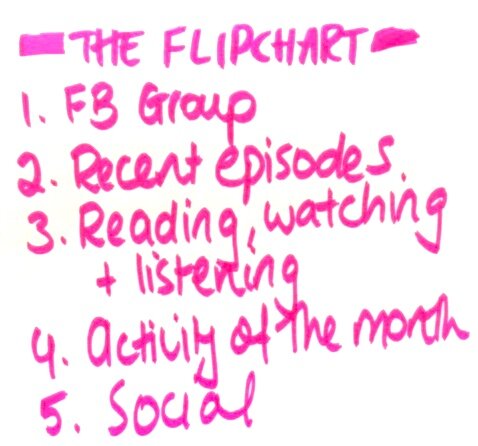 Join fellow listeners and facilitators on our Facebook group, The FlipchartThe reason I started this group is because, as a facilitator, I spend a lot of time scouring the internet and YouTube, trying to find a perfect activity, exercise, game, video, image to support my learning material. I’m sure there’s a few of you out there who are doing the same thing! Let’s make it easier for each otherThis is a global community for facilitators who want to get better at their craft, and also more efficient at developing their workshop content. In this group, we share awesome training tips, hacks and recommendations to help you with the next workshop you deliver. Jump on board! Recent First Time Facilitator podcast episodes
Join fellow listeners and facilitators on our Facebook group, The FlipchartThe reason I started this group is because, as a facilitator, I spend a lot of time scouring the internet and YouTube, trying to find a perfect activity, exercise, game, video, image to support my learning material. I’m sure there’s a few of you out there who are doing the same thing! Let’s make it easier for each otherThis is a global community for facilitators who want to get better at their craft, and also more efficient at developing their workshop content. In this group, we share awesome training tips, hacks and recommendations to help you with the next workshop you deliver. Jump on board! Recent First Time Facilitator podcast episodes
- This week I talk about a facilitator packing checklist. Grab a copy of the Google Sheet checklist here - you can copy it to your own google docs drive and customise it for any upcoming workshops you have.
- Storytelling is powerful, how good are you at capturing and weaving stories into your workshops? If you need some tips, listen to my conversation with Hadiya Nuriddin
- "Life is too short for bad presentations"! One of the best statements, ever (in my opinion). This quote came from Toon Verlinden, a chemical engineer in Belgium. Listen to how Toon and his co-author, Hans Van De Water are helping academics present better.
Reading, watching and listening
- Meeting Tips Radio was a podcast from 2014 with 16 episodes only, however I binge listened to every episode prior to facilitating a global Executive strategy session recently, where I discovered the ToP methodology and ORID. If those acronyms don't make any sense to you, listen to the podcast! I'll also be interviewing a few facilitators on the ToP methodology in future episodes.
- I've also been watching Tom Bilyeu's Impact Theory on YouTube - the interviews are great, but I've been observing the way Tom introduces his guest. His introductions are some of the best I've seen. Watch him introduce Seth Goden.
- The Do Lectures put together this list of the 100 must-read books of 2018. I have collected a ton of Audible credits over the last few months, I know what I'll be using them for! I think I'll start with Cal Newport's 'Digital Minimalism'.
Activity of the month: Space Team'Space Team' is an group player app I played at the 'We Are Podcast' speaker's retreat last week (my podcast hero, Pat Flynn told us about it). I think you could weave it into a team-based activity around delegating tasks and the importance of listening.You can see how the Space Team app works here.About the app: Basically up to 8 people with a randomly generated set of space ship controls on your screen that you have to operate on command before you blow up but your instructions are sent to another random player.After playing a few rounds, our group decided on strategies - which involved a focus on listening more, taking stock of your controls to start with, and being responsive when you actioned a task.SocialI'd love to chat with you on social media!
- Instagram @firsttimefacilitator (or if you like photos of sausage dogs, running, behind the scenes stuff @leannehughes)
Happy facilitating!Leanne
Being comfortable (with feeling uncomfortable): My public speaking journey
This is a transcript of Episode 27 of the First Time Facilitator podcast.Usually on the show I interview amazing facilitators, speakers and leaders but I’m going solo for today’s episode. This is the third solo episode I’ve recorded and these ones are usually spurred on by questions I receive from listenersSo the question this week was from a colleague and it was this:
“Leanne, how did you get the confidence to speak in front of large groups?”
There's a bit to unpack in that question. Its different for everyone. Interestingly, this question is about confidence; not about developing the skill.I'm going to share the real opportunity I had that lead me to feel more confident and now accept opportunities where I do speak in public. In saying that, I’m still human and continue to question my ability before accepting these opportunities. However, after talking to fellow facilitators and speakers on the podcast, that appears to be a fairly normal response. I guess the good thing about type of response, is that it keeps you on your toes and not operating in autopilot.The definition of large group is also different from everyone. I think anything above 30 is pretty large. From my experience, anything above 30 or 40 requires a microphone, probably a stage and some bright lights. I can give you a short and long answer for this but I took this question as a really good opportunity to reflect on the things that I actually did to position myself to accept large group speaking opportunities, with perceived confidence.
It was October 2014
I was living in a small, coastal regional town in Western Australia called Broome. I talk about Broome in a lot of episodes as I have find memories there. Imagine a place where in winter, you can swim at the beach, in summer it’s too hot to do anything. The population is very small, about 15,000 people. The closest town is a 2 hour drive away, the nearest capital city is Jakarta, Indonesia. You don’t really do things there. Your weekend plans are dictated by the tide times, everyone drives a 4wd and you spend most of your time in air conditioning, down the beach camping and fishing, with a cold beer in hand. It was wonderful! However living there for 3.5 years you can become pretty complacent, and outside of work, I wasn’t really achieving a lot. I wanted to create some more discipline for myself.I thought I would set myself a ridiculous goal, something that would get me out of bed nice and early… literally... and that was to run a marathon. It was a big goal because growing up, I hated running. I loved playing netball, but I loathed the fitness element - I associated running with everything negative in life. However, living in this coastal town, there were no hills, no traffic, and because nothing really happened in town, I had time up my sleeve. This gave me the ultimate entry point to start. So I signed up for the GC Marathon.Not having a clue on how to do this, I enlisted a coach Pat Carroll. He’d won a few Gold Coast marathons. My goal was to simply finish under 5 hours.On a side note, this is a speech I did at Pecha Kucha, Broome about the whole marathon training experience.I’m sharing this story as there were a couple of words of phrases he said, that I think can generally be applied to this question about gaining confidence in speaking in front of large groups.I'm going to drop one of those phrases now and then again later on, in the episode. Pat said that a lot of people approach runs and start cross-training, ie. Do weights, swim or cycle. But HE SAID - and gosh, it sounds so simple - and you’re probably going to think I’m crazy to highlight this as some kind of watershed moment - but it was for me...
It was wonderful! However living there for 3.5 years you can become pretty complacent, and outside of work, I wasn’t really achieving a lot. I wanted to create some more discipline for myself.I thought I would set myself a ridiculous goal, something that would get me out of bed nice and early… literally... and that was to run a marathon. It was a big goal because growing up, I hated running. I loved playing netball, but I loathed the fitness element - I associated running with everything negative in life. However, living in this coastal town, there were no hills, no traffic, and because nothing really happened in town, I had time up my sleeve. This gave me the ultimate entry point to start. So I signed up for the GC Marathon.Not having a clue on how to do this, I enlisted a coach Pat Carroll. He’d won a few Gold Coast marathons. My goal was to simply finish under 5 hours.On a side note, this is a speech I did at Pecha Kucha, Broome about the whole marathon training experience.I’m sharing this story as there were a couple of words of phrases he said, that I think can generally be applied to this question about gaining confidence in speaking in front of large groups.I'm going to drop one of those phrases now and then again later on, in the episode. Pat said that a lot of people approach runs and start cross-training, ie. Do weights, swim or cycle. But HE SAID - and gosh, it sounds so simple - and you’re probably going to think I’m crazy to highlight this as some kind of watershed moment - but it was for me...
He said, "The best way to train for a marathon is, to simply, run".
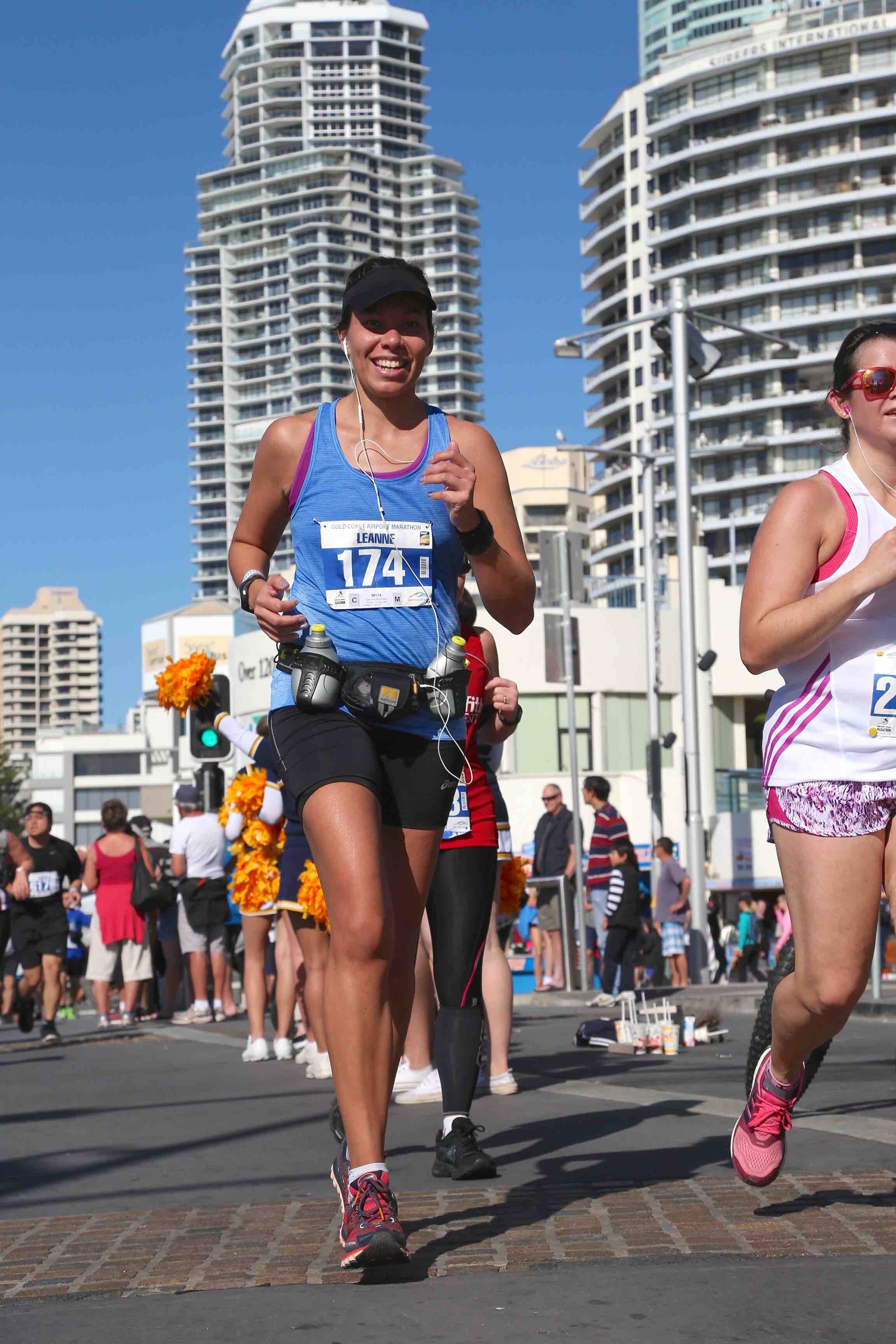 You need to start banking those kilometres on your legs. You don’t need to do pilates, swim, hike, or play touch footy. Just run. Bank those kilometres on your legs. I loved that concept of banking kilometres. And I banked thousands of kilometre on my legs in those nine months.My most recent podcast guest, Neen James agrees with this. If you listened to my conversation with Neen in Episode 26, you would have heard her mention the phrase ‘Time on your feet.’So my short answer to that question, ‘How did I get the confidence to speak in public?’, well it was really about banking that time on my feet as a speaker.That leads onto the next question:
You need to start banking those kilometres on your legs. You don’t need to do pilates, swim, hike, or play touch footy. Just run. Bank those kilometres on your legs. I loved that concept of banking kilometres. And I banked thousands of kilometre on my legs in those nine months.My most recent podcast guest, Neen James agrees with this. If you listened to my conversation with Neen in Episode 26, you would have heard her mention the phrase ‘Time on your feet.’So my short answer to that question, ‘How did I get the confidence to speak in public?’, well it was really about banking that time on my feet as a speaker.That leads onto the next question:
How do I find time in my feet, so when a marathon-like speaking opportunity comes along, I’m prepared?
If you go through school and Uni, that’s a good start and there are opportunities there, like high school English class presentations or the dreaded group assignment preso at University.I’ve also always loved seeing others kill it on stage. I have always been fascinated by the power of strong delivery, and what brilliant presentation looks like. I guess the difference I brought, was to continually to ask myself, "What can I do that is different? Who is in the audience, what do they want, what is the hook?”When I really think about why I care so much about making sure my message hits… it probably comes back to my philosophy about how life is too short.In Episode 16, I spoke with Adam Mustoe about the Gallup Strengths Finder 2 and my second highest strength theme is Maximiser. The Maximiser theme is really around ‘Do you want fries with that?’ and taking advantage of opportunities…you get caught out sometimes, particularly when travelling as you want to cram and juggle everything into a day. How this theme plays out also is that if I’m given the opportunity to present in front of other people, I want to maximise that moment. I believe you are in a position of great opportunity the second you have more than two people in the room. Life is too short to have your time wasted by boring, irrelevant and un-memorable presentations. When you’re the one in front of that room, don’t waste everyone else's time.And that’s my real driver for doing things differently.
Sport played a role.
I was lucky getting into netball from the age of 10. Through the game, I’ve been given opportunities to speak in front of others at occasions from speaking in team huddles during quarter breaks, to club presentation nights and dinners.In University, I started coaching more junior teams and I believe being a coach had a significant impact on my ability to deliver a message succinctly and projecting my voice - particularly when you have quarter and half time breaks to do that and your audience are 13 to 15 year olds.My first official MC gig was as on-court announcer for the Queensland State League netball finals back in 2003. I called the teams on the court, thanked sponsors, talked through key highlights of the match. Through this, I learned about the importance of time-keeping, how to speak clearly into a microphone, and the realisation that the role of MC is so much more than just the delivery. There is a lot of background work involved in who you need to liaise with, what your backup plans are, etc. Now when you start doing this sort of stuff, the people around you hear about it, and that opened doors as an MC’ing at friend’s weddings.
If you’re ever asked to MC a wedding, please say yes.
For two reasons in particular:
- It keeps you off the booze for a few hours so that you can avoid a painful hangover!
- The skill to being a wedding MC is about really making it a personal experience. So this experience forces you to tailor your message -for the couple, family and friends. Having that first wedding MC gig again opened up more invites to MC other events.
Can you see from this trail how it all works?
If we’re relate speaking back to running, I believe those school, netball and uni presentations were 5km runs. MC’ing a wedding is a half marathon.And unfortunately, similarly to running, you can’t go cold turkey for 6 months and then expect to run at the same pace you did while training.
So how can you continue to get that speaking experience?
I know a lot of the listeners are split, probably about 50% working in a full-time job and 50% freelance. For those working, there are so many opportunities to put your hand up and deliver presentations from where you stand.While I was working in Marketing for a company called Wicked Campers, we were sponsors of the annual Backpacker travel expo in Melbourne. As part of the sponsorship package, the company was offered an opportunity to run some sessions on travelling around Australia.I put my hand up.In my role working in Government in regional Western Australia, we had a fortnightly Friday morning video hook-up with the other campuses in the region called Communication Corridor. 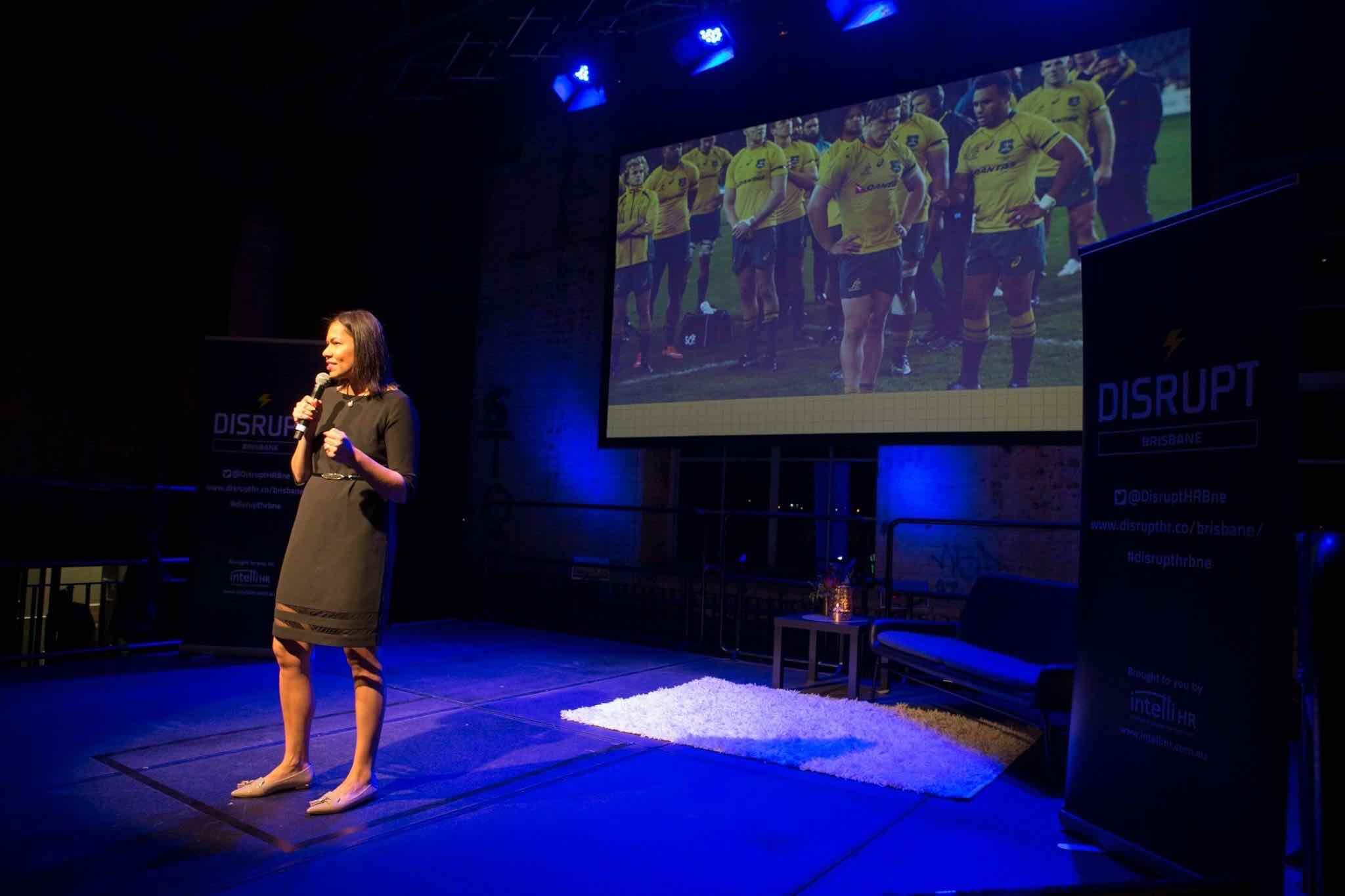 As I needed to share internal messages, I put my hand up and asked to be in the agenda, pretty frequently. I challenged myself to out-do my previous presentations over and over again.When it came to Friday morning, I also felt like whacking myself on the head and questioning myself on volunteering for these sessions and putting myself under undue pressure. It would have been much easier not volunteering and sitting in the crowd every fortnight, But, when we held a Professional Development week for all 200 staff in the region, guess who was asked to MC the event?In late 2016, I was asked to co-facilitate some leadership training in Brisbane. A few months later and I was onboard a flight to Canada to run the same workshop over there.
As I needed to share internal messages, I put my hand up and asked to be in the agenda, pretty frequently. I challenged myself to out-do my previous presentations over and over again.When it came to Friday morning, I also felt like whacking myself on the head and questioning myself on volunteering for these sessions and putting myself under undue pressure. It would have been much easier not volunteering and sitting in the crowd every fortnight, But, when we held a Professional Development week for all 200 staff in the region, guess who was asked to MC the event?In late 2016, I was asked to co-facilitate some leadership training in Brisbane. A few months later and I was onboard a flight to Canada to run the same workshop over there.
Time on your feet matters.
Not only does it give you more time to practice your presentation skills and experiment with content, but more importantly, you also get used to that feeling of uncomfortable-ness. You get comfortable with being uncomfortable. It also leads you to good things and great opportunities that you would never have realised. Every time you step up, it’s an opportunity for you to market yourself and build your personal brand. You get luckier. I think the best analogy that sums this up is the one I heard on Episode #49 of the Jordan Harbinger show. In this episode, Jordan chats to Alex Banayan about mentoring. In fact, its so good, I am going to share it for you below:There's no denying that luck plays a role in anyone's success.But it was in conversation with then-Microsoft executive Qi Lu that gave Alex a real understanding of lucks role in success.Qi Lu had grown up in a village outside of Shanghai, China that was so poor to the extent that there was only one teacher per 300 children and people developed deformities from malnutrition. Being very smart and working very hard, Qi was making seven dollars a month by the time he was 27. Like so many other intelligent, hard workers in China, he dreamed of a better life in America — so, he needed an advantage over the competition.As luck would have it, Qi had the opportunity to speak to a Carnegie Mellon professor lecturing at his local university. The professor had been so impressed by the questions he was asking and the papers he had written about the professor's area of expertise that Qi was offered a full scholarship to Carnegie Mellon.How did luck play into it? Under normal circumstances, Qi would have ridden his bicycle to visit his parents on that particular night of the week — but it was raining, so he stayed on campus, attended the lecture, and happened to be the most well-informed scholar in the room on the topic at hand. Thanks to his extra months of productivity, he was prepared when opportunity knocked.To Alex, Qi imparted this nugget of wisdom: Luck is like a bus. If you miss one, there will always be the next one. But if you are not prepared, you won't be able to get on.This encouraged Alex to do a little more digging into the science of luck, and from the research, it seems one thing is clear: luck is a mindset, not a phenomenon.
When I again reflect on that question, how did you get the confidence to speak in front of large groups?
As you can see, it’s an evolution piece underpinned by three things:
- Bank that time on your feet.
- Put your hand up and find the opportunities.
- Every time you have an opportunity to present, challenge yourself to stretch and outperform your previous presentation.
The second piece of advice from my running coach, Pat Carroll was not to be concerned by the fact that your longest training run does not take you near 42.2km. Save yourself for the marathon. Prepare consistently, stay injury free, and your solid preparation combined with race day atmosphere will allow you to go all the way.Nothing will prepare you for that marathon moment in front of hundreds of people with the spotlight on you, but you’ll get pretty close by banking the thousands of kilometres prior, and you can be confident to accept the opportunity, given the success you’ve had in the past.
I'd love to hear how you got your speaking experience.
How will you find that time on your feet? Where are you banking your speaking kilometres? Comment below!
The Flipchart (August 2018)
The FlipchartA resource for First Time Facilitators |
Hello friends,Welcome to The Flipchart, your monthly First Time Facilitator highlights reel.This monthly (ish) email is includes a curated list of tools and resources to help you make a bigger impact at the next workshop you deliver.
Recent First Time Facilitator podcast episodes
- When facilitating a workshop, how do you balance being present, with forecasting ahead to drive an outcome? This is one of the topics I explore this week with Mark McKeon, who spent 16 years as the high performance coach for the Collingwood AFL club. He's also an accomplished author, speaker and facilitator. In Episode 25, we talk about about the parallels between creating high performance on the footy pitch; and high stake situations in a group workshop facilitation environment.
- In Episode 24, I'm delighted to introduce listeners to my colleague, Sean Lavin. We both recently gained Team Management Profile (TMP) accreditation, so this was a great opportunity to reflect on that experience, how powerful the TMP can be and learn more about Sean’s journey leading workshops. I've started to profile tools like TMP as there was a great response from my conversation with Adam Mustoe in Episode 16 about the Gallup Strengths Finder tool.
- In Episode 23 I talk to one of the masters of facilitation, Lynne Cazaly. This one is full of facilitation gold. We talk about the power of visuals, strategies to retain attention, and we share opinions on the type of icebreakers they should have thrown out in the early ‘90s.
Energiser of the month: Drawing Twins
Time: 20-30 minutes
Objective: This should illustrate how hard it is to give clear instructions as well as how hard it is to listen, and can also show how things are easily misunderstood and misinterpreted.
Equipment: Pen, paper and simple line drawn pictures (eg. house, face, spider, various shapes on a page, tent, car)
Instructions
Divide participants into pairs.
Round 1:
- Give one member of the pair a picture which must not be shown to their partner.
- The person with the picture must give instructions to their partner so that they can draw it, but must not say what it is, eg, ‘draw a circle, draw two more circles inside the circle about half way up’. The person with the picture cannot watch the person draw it.
- Compare the drawing with the original.
Round 2:
- Hand out more pictures and ask participants to swap roles.
- The person with the picture can give instructions in a similar manner as in Round 1 but this time the person drawing can ask yes/no questions and the person with the picture can watch as they draw.
- Half the group can begin by telling the person what the object is.
Debrief questions:
Round 1:
- Why don't many of the pictures look like the original? (Interpretation: everyone has a different interpretation, directions were not clear, not able to give or get feedback).
- What were your frustrations as the source of the message (giving instructions), as the receiver of the message.
Round 2
- Did it help to be able to watch the person drawing?
- Did it help to be able to ask questions?
- Did it help to know what the object is …your clear goal?
Relate this process back to communicating with your employees. Is your message always clear? Is there a channel to give and receive feedback? What noise is present that affects the message?
Let me know if you use this in your next workshop and how it goes!
Reading and listening
- Have you ever thought 'I'm not creative?' I believe everyone has the ability to channel their inner creative genius and this was confirmed when I listened to this podcast on the Jordan Harbinger show. Listen to his interview (and share it with someone you overhear saying 'I'm not creative': Allen Gannett | You Don’t Have to Be a Genius to Be Creative
- First Time Facilitator was recently named in the Ultimate L&D Podcast list for 2018. Unreal! Thanks for all of your support. This is a list of all the active, English-language, Learning & Development podcasts that there are, all in one place for your own learning & development.
- Speaking of podcasts, I'm co-MC at this year's 'We Are Podcast' conference on October 18-20 in Brisbane, Australia. If you've ever thought about starting your own podcast, or meeting your podcast heroes, check out the page - tickets went on sale this week.
One more productivity hack...
I am sticking with the iPhone 6 for the moment as it's the latest version with a headphone jack - yes I'm a traditionalist in some ways! I wanted to share this tool from one of my favourite authors/thought leaders, Jenny Blake:
- With my iPhone 6 now losing it's charge within the day, this lipstick-sized (a slight exaggeration - let's call it a jumbo lip gloss) Anker PowerCore+ mini portable phone charger is a must-have. I also put my phone in "low battery mode" every morning by default (you can add this as a quick "button" in the iPhone's Settings —> Control Center so that it's quickly accessible when you swipe up from the bottom). By doing this, the charge lasts all day (faaaaaar longer than when in regular mode).
Til next month,Leanne
|
\
The 7 attributes of a superhero facilitator and how to rescue a workshop or meeting from a fate worse than death.
 It’s Monday morning and you’ve donned your day job attire. You’re sitting in your cubicle, minding your own business, when suddenly a civilian colleague approaches. You chat about your respective weekends, then they pause and ask “Hey, what are you up to next Thursday morning? Can you facilitate our team meeting?”You feel surprised (and flattered) and accept. Moments after they walk away, you think to yourself “Why did they pick me? Why on earth did I say yes? I have no idea what to do!”Firstly, congratulations on saying yes! That’s a big win. Superhero facilitators are often caught off guard but are always up for the challenge. So it’s time to bust open the button-down shirt and reveal the proverbial multi-colour Lycra suit of Super Facilitator.For the purpose of this article, let’s define the responsibilities of a facilitator. A facilitator is there to:
It’s Monday morning and you’ve donned your day job attire. You’re sitting in your cubicle, minding your own business, when suddenly a civilian colleague approaches. You chat about your respective weekends, then they pause and ask “Hey, what are you up to next Thursday morning? Can you facilitate our team meeting?”You feel surprised (and flattered) and accept. Moments after they walk away, you think to yourself “Why did they pick me? Why on earth did I say yes? I have no idea what to do!”Firstly, congratulations on saying yes! That’s a big win. Superhero facilitators are often caught off guard but are always up for the challenge. So it’s time to bust open the button-down shirt and reveal the proverbial multi-colour Lycra suit of Super Facilitator.For the purpose of this article, let’s define the responsibilities of a facilitator. A facilitator is there to:
- Guide people with different work styles, personalities and values through a process to reach the meeting objectives.
- Ensure active participation from all members of the group and draw out their opinions and ideas.
- Keep the group focused on the agenda and moving forward.
So, how does a facilitator carry out these responsibilities like a superhero (Lycra optional)?
1. A superhero might be able to see through walls, but they can’t see into the future. A superhero facilitator must predict and prepare for a number of possible outcomes.
Most skilled facilitators spend 2 to 3 times as long preparing than the amount of time they spend at the actual session. I think that’s a great ratio to work with, particularly if you’re just starting out.So, how on earth do you spend that preparation time? Superhero facilitators don’t leave any scenario unplanned for and they always have a plan B, C, D and E.
Who’s who in the zoo?
Dig into the details of the group, such as the individual personalities, their motivations, and the overall group dynamics. What’s the history of the group? Why are they seeking an external facilitator? Have they tried to achieve these meeting outcomes previously?
What does the successful superhero mission look like?
Examine the group’s objectives. What will it take from you to get them there? Do you think the allocated time is sufficient? What will you suggest as an option if an outcome can’t be reached in that time?
Is the space fit for purpose?
The environment and general climate of a meeting or planning session sets an important tone for participation. Is the site accessible to everyone? Is the space the right size? Is the audio-visual equipment a breeze to set up?
Make a checklist of everything you will need, down to the last minute detail.
I recently ran a session which required a deck of card to be cut in half. Ten minutes before the workshop commenced, I realised my laser vision was playing up and I didn’t have a pair of scissors handy. It was a stress that was neither necessary nor fun. Save yourself the drama and write down all of the resources that you’ll need. Even everyday facilitators should have a structure and an idea of the general direction the session should take. Superhero facilitators however, know that nothing ever goes to plan. Having plenty of options to draw on will provide you with flexibility and allow you to change things up based on the group’s needs.I have been leading one-day induction sessions where a variety of speakers deliver consecutive sessions. As you can imagine, over the course of the day, there are times where we gain or lose time against the loose schedule. The first time the session ran I had only planned one back-up activity, which we used before morning tea. Lesson learnt. The second and subsequent times, I had five games up my (Lycra) sleeve and associated resources. Having that flexibility is important, will give you confidence and your future self will thank you for it.
Even everyday facilitators should have a structure and an idea of the general direction the session should take. Superhero facilitators however, know that nothing ever goes to plan. Having plenty of options to draw on will provide you with flexibility and allow you to change things up based on the group’s needs.I have been leading one-day induction sessions where a variety of speakers deliver consecutive sessions. As you can imagine, over the course of the day, there are times where we gain or lose time against the loose schedule. The first time the session ran I had only planned one back-up activity, which we used before morning tea. Lesson learnt. The second and subsequent times, I had five games up my (Lycra) sleeve and associated resources. Having that flexibility is important, will give you confidence and your future self will thank you for it.
2. A superhero facilitator never underestimates their audience’s basic needs.
Civilians, I mean participants, get hungry and lose focus and enthusiasm. Catering is important. I can’t tell you the number of times I’ve read through feedback sheets and over 50% of the comments relate to food. I’m serious. From my experience, keep the hot savouries for morning tea and the sweets for afternoon tea. Grumbling stomachs take your participants’ minds off the meeting. Oh, and bad coffee is like kryptonite. Ensure good coffee, every time (or, at the very least point the participants in the direction of a great café and give them time to grab one). Sometimes this decision is out of your control, but a superhero facilitator will influence the decision.Speaking of distractions, you don’t need to use your x-ray vision to scan for non-verbal cues from the group. Hone in if someone appears to be disinterested and watch to see how that effects other members in a team. Are people shifting in their seats? Are they bored or looking confused? If they seem restless, either take a break, speed up or slow down the meeting pace.Sometimes you will need to match the activity you have in mind with the energy in the group (another reason to have a variety of them in your kit). Other times, you’ll need to find a new way to boost a low-energy group’s enthusiasm. Take care, notice your group’s energy levels and inject interest when it’s needed to help them operate at their best.
3. A superhero facilitator can segue like a boss.
Groups have a tendency to roam far from the original agenda and often need rescuing to bring them back to the core discussion. When you notice them wandering off, bring it to the group’s attention by saying something along the lines of “That’s interesting – perhaps we should get back to the original topic”. Bonus points if you can somehow segue the distraction into the next agenda item!Many groups will discuss an outcome for far longer than they need to unless you help them recognise that essentially, they’re agreeing on the point. If you pick this up, ask someone in the team to summarise the points of agreement.If one or two individuals disagree, state the situation as clearly as you can: “Lex and Lois seem to have other feelings on the matter, but everyone else thinks [insert statement here]. Perhaps we can decide to go in the direction that most of the group wants, and they can get back to us on other ways to accommodate their concerns.”Be wary when deciding where the meeting should go. Check back to see if there are questions and then summarise and provide the next steps or actions for the group.
4. A superhero facilitator has a sixth sense for group dynamics.
You need to find ways to ensure the entire group is on an equal playing field, and inclusivity is the name of the game. Sometimes you’ll need strategies to deal with disrupters, and like most potentially dangerous situations, I am of the firm belief that prevention is better than cure.At the beginning of the workshop, gain agreement on the agenda, ground rules and desired outcomes. Also cover what’s not in scope and highlight anything that’s not covered in the meeting. Building a relationship with a new group requires you to find some common goals and interests, shared values and outlooks. If power players are in the room, acknowledge their influence and role. Empower them by giving them a role to play during the meeting.Using this time at the start of the meeting will also allow you to get a feel for the individuals in the group; wall flowers who might need extra support and big hitters who may need to be managed.The ‘dominator’ is the most common workshop villain (aka disrupter). They try to steer the discussion away from what you’re meant to be talking about, have side conversations with the person sitting next to them, and attack others’ ideas. As a facilitator, your first step is to recognise that the floor needs to be shared around.
5. A superhero facilitator knows the right questions to pitch, at the right time.
Facilitators ask questions primarily to help participants clarify their thoughts and evaluate information. Use a combination of open-ended and closed questions. One framework you can employ is the APPLE technique:
- A – Ask the question.
- P – Pause to allow participants to comprehend the question and formulate an answer.
- P – Pick a member to provide an answer.
- L – Listen to the answer.
- E – Elaborate on the answers obtained.
Some good question-starters include:
- “Tell me about…”
- “What would happen if we…”
- “In your experience…”
- “What do you think about…”
6. A superhero facilitator draws on extraordinary interrogation tactics (Active Listening).
Mirroring, paraphrasing and tracking are three tools you can leverage to help you with active listening. Mirroring is when you repeat back the speaker’s words verbatim. It helps the speaker hear what they just said, shows neutrality and can help to establish trust.Paraphrasing is a way to show the speaker and the group that their thoughts were heard and understood. Unlike mirroring, paraphrasing is using your own words to explain what you think the speaker said. For example “It sounds like you’re saying [insert paraphrased content]. Is that what you mean?”Lastly, tracking is when you’re keeping track of various lines of thought that are occurring within a single discussion. It helps to summarise the different perspectives and show that multiple ideas are equally valid.
7. Superhero facilitators must bide their time – they have unwavering patience.
Like most missions worth embarking on, becoming an effective facilitator takes practice. The good thing is, you CAN learn all of these skills (and laser vision really isn’t essential).Remember, each group is different and as you sharpen your skillset, you’ll intuitively figure out what works best for the team, the meeting and the organisation.I’d love to hear your thoughts on this article. Do you think any superhero facilitator attributes are missing? Comment below.
A 45 Minute Workshop Outline on Public Speaking with ImpaCCCT
I met Petra from ImpaCCCT when we presented at the first instalment of Disrupt HR this year. She invited me to share my tips on communication and in particular, public speaking to her Best Talents Meetup Group in the Brisbane CBD last week. And I only had 45 minutes.Phew, such an open topic! There are so many elements to public speaking. I didn’t really know where to start. Upon reflection, I’ve discovered a common pattern to the way I work when I’m asked to deliver a workshop or speech.Download a one-pager checklist that I use to craft any type of presentation.I used this one-pager as a focal point for discussion at the Meetup. This allowed me to give the audience direction, set expectations and also gave them a prompt to ask questions. What was interesting was how the questions that were asked directed the conversation to things I hadn’t even considered discussing that morning.
How the Meetup Started
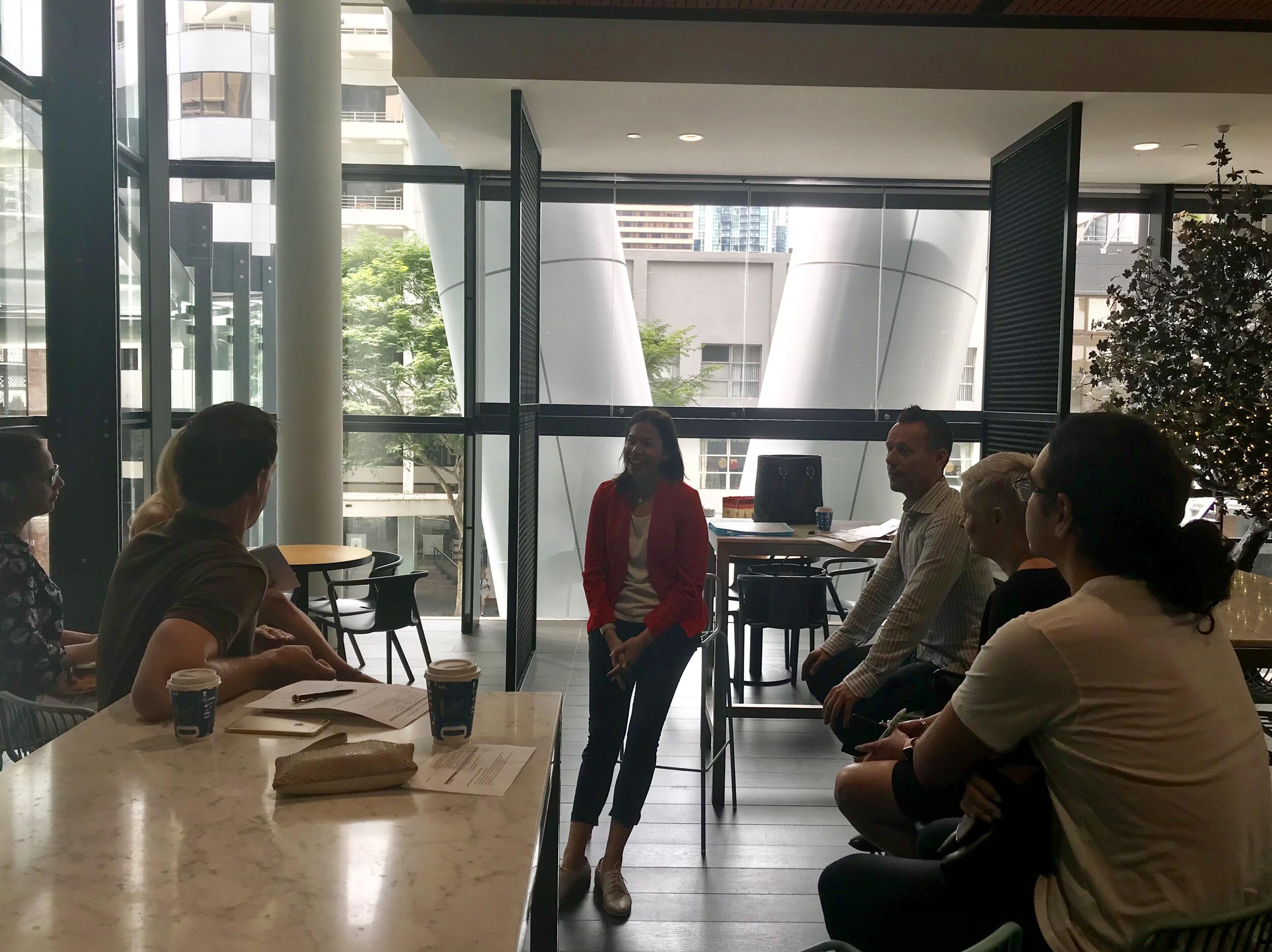 Yes, we met in a public space (a café), but that was no excuse. It was 8am and we began by warming up our voices. We all stood up, stretched our arms in the air, sighed, rolled our tongues, sang out some ‘la la la’s’ and introduced ourselves. We then shared what had brought us to the Meetup that morning and outlined details of the worst presentation we had ever seen.Warming up your voice is essential before speaking in any defining moment in your life. If you need tips, watch this video from Julian Treasure: How to speak so people want to listen.
Yes, we met in a public space (a café), but that was no excuse. It was 8am and we began by warming up our voices. We all stood up, stretched our arms in the air, sighed, rolled our tongues, sang out some ‘la la la’s’ and introduced ourselves. We then shared what had brought us to the Meetup that morning and outlined details of the worst presentation we had ever seen.Warming up your voice is essential before speaking in any defining moment in your life. If you need tips, watch this video from Julian Treasure: How to speak so people want to listen.
Mastering public speaking - it’s all about the ‘ouch’ moments
After warming up our voices, I shared the Ladder of Learning model. This is one of my favourite Learning and Development models that I use in a lot of workshops.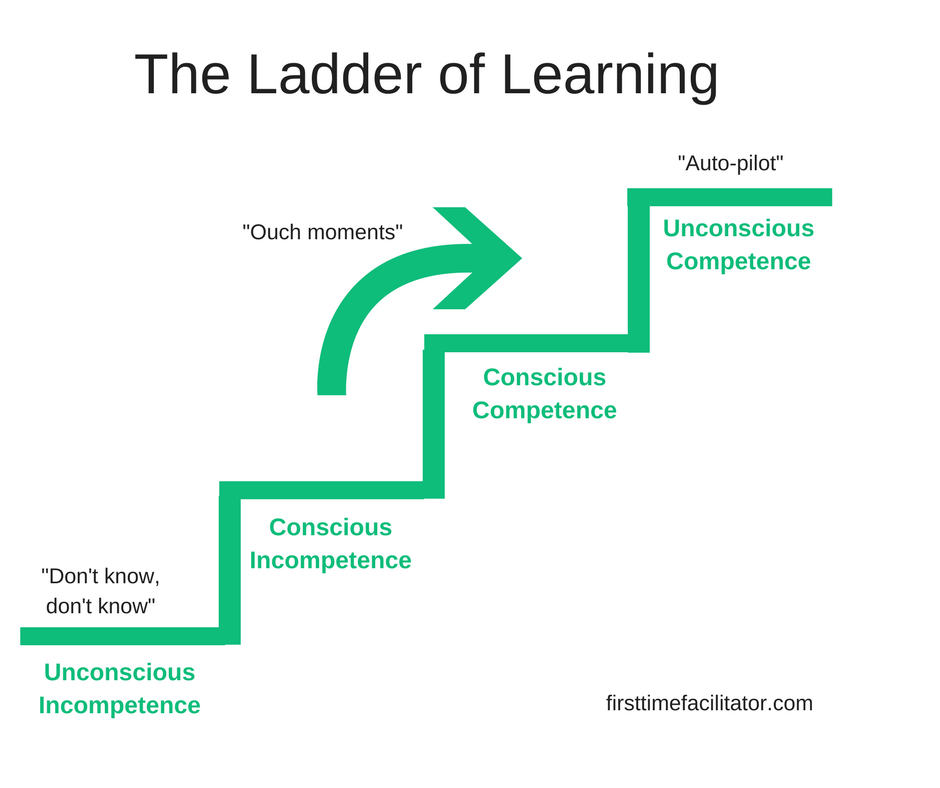 The model demonstrates that the key to any type of Skill Mastery is accepting (and embracing) that you’re going to experience ‘ouch’ moments - times where it’s really uncomfortable. Think back to the time when you were learning how to drive. It was extremely nerve-wracking and frustrating - particularly if you were driving a manual car and navigating a hill-start! It felt like mastering the skill of driving would never happen. Thought, it was worth the perseverance, because the rewards of driving were too great. Driving meant independence and accessibility; graduating to an adult world.It’s the same with public speaking. We can sit back, comfortably stagnant in the ‘Conscious Incompetence’ zone, or we can choose to invest, practice and tackle those ‘ouch’ moments to graduate to the ‘Conscious’, or even ‘Unconscious Competence’ status when we’re at the front of the room.What does the ‘ouch’ moment look like when it comes to public speaking?
The model demonstrates that the key to any type of Skill Mastery is accepting (and embracing) that you’re going to experience ‘ouch’ moments - times where it’s really uncomfortable. Think back to the time when you were learning how to drive. It was extremely nerve-wracking and frustrating - particularly if you were driving a manual car and navigating a hill-start! It felt like mastering the skill of driving would never happen. Thought, it was worth the perseverance, because the rewards of driving were too great. Driving meant independence and accessibility; graduating to an adult world.It’s the same with public speaking. We can sit back, comfortably stagnant in the ‘Conscious Incompetence’ zone, or we can choose to invest, practice and tackle those ‘ouch’ moments to graduate to the ‘Conscious’, or even ‘Unconscious Competence’ status when we’re at the front of the room.What does the ‘ouch’ moment look like when it comes to public speaking?
- Saying ‘YES!’ to speak when your immediate gut response is ‘NO!’
- The knots in your stomach the night/week before your big presentation (this is a good signal to buckle down and ensure your preparation is spot-on).
- Attending a Meetup about Public Speaking.
New contexts or environments can sometimes slip us down the ladder
I’ve learnt that a change in context or environment can force a slip down the ladder. Again, an example I used was driving. In Australia, I see myself in the ‘Unconscious Competence’ sector - when I drive, I feel like I’m on autopilot. However, when I traveled to Canada earlier this year I slipped back into ‘Conscious Competence’ where I was actively thinking about every action I took when I was in the driver’s seat. I even had a post-it note on my steering wheel reminding me which side of the road to stay on.It’s the same with presentations. Over our career, we can be comfortable presenting in front of the same audiences and in the same room (‘Unconscious Competence’) and suddenly you’re wheeled in front of the Board. The stakes are higher and your nerves are heightened - which may have you slipping back into ‘Conscious Competence’. This isn’t a bad thing - it’s great and gives you more ‘ouch’ moments, which will help you improve over time. To evolve as a public speaker, look for opportunities that are at the next level and continually challenge you.
What about the most high-stakes environment of all time, the dreaded job interview?
An environment where the pressure and stakes are at an all-time high is the job interview.A couple of participants attending the Meetup were in job-hunt mode and were quite early on in their careers. In many job interviews, you’re asked to provide examples of situations where you have demonstrated a particular skill. We have all been asked a question that starts with, ‘So, tell me about a time when…’.My advice is to start collating story examples early in your careers. I would use a simple template like this one:[table id=2 /]If you start collecting your life experiences and transcribing them into a simple Google Sheets table, you can weave them into any presentation - not only the job interview. In future when you’re writing a speech you then have a database of some personal anecdotes you can utilise to demonstrate a point. This is gold. It’s very tricky thinking of those stories off-hand.You can even start a folder in your inbox called ‘Stories’ and drag emails that remind you of a great story to this folder as an even easier way to start.We spent the remainder of time talking through the one-pager handout which included the following information split into three major categories:
- Preparation.
- Crafting your content.
- Presenting with power - for more tips, view my article Disrupt HR: The Creative Process in 7 Simple Steps
[table id=1 /]Download a one-pager checklist that I use to craft any type of presentation.If you’re in Brisbane, join the Best Talents Meetup group and join us for a monthly coffee and 45 minutes of top content!
35 Lessons I Learnt at the ‘We Are Podcast’ Conference
A few months ago I was cruising Eventbrite, having a look to see what events were coming to Brisbane and I saw an event titled We Are Podcast. Curious, I clicked the link and couldn’t believe the speaker list - podcast celebrities from the US who I frequently listen to on my daily commute; the likes of Jordan Harbinger from Art of Charm and John Lee Dumas from Entrepreneurs on Fire.I don’t have a podcast (yet) but I thought it would be an interesting way to learn about this medium. Without thinking about it too much, I paid my $690 registration fee, asked the boss for annual leave… and I was in.What a great decision. I’ve summarised the top three things I loved about the conference and also included a list of the top 35 lessons I learnt.Author's note, this is an informative post capturing my key notes from the conference, without too much reflection on what I'll do with them - more on that in future articles!
1. Putting the ‘Present’ into ‘Presenters’
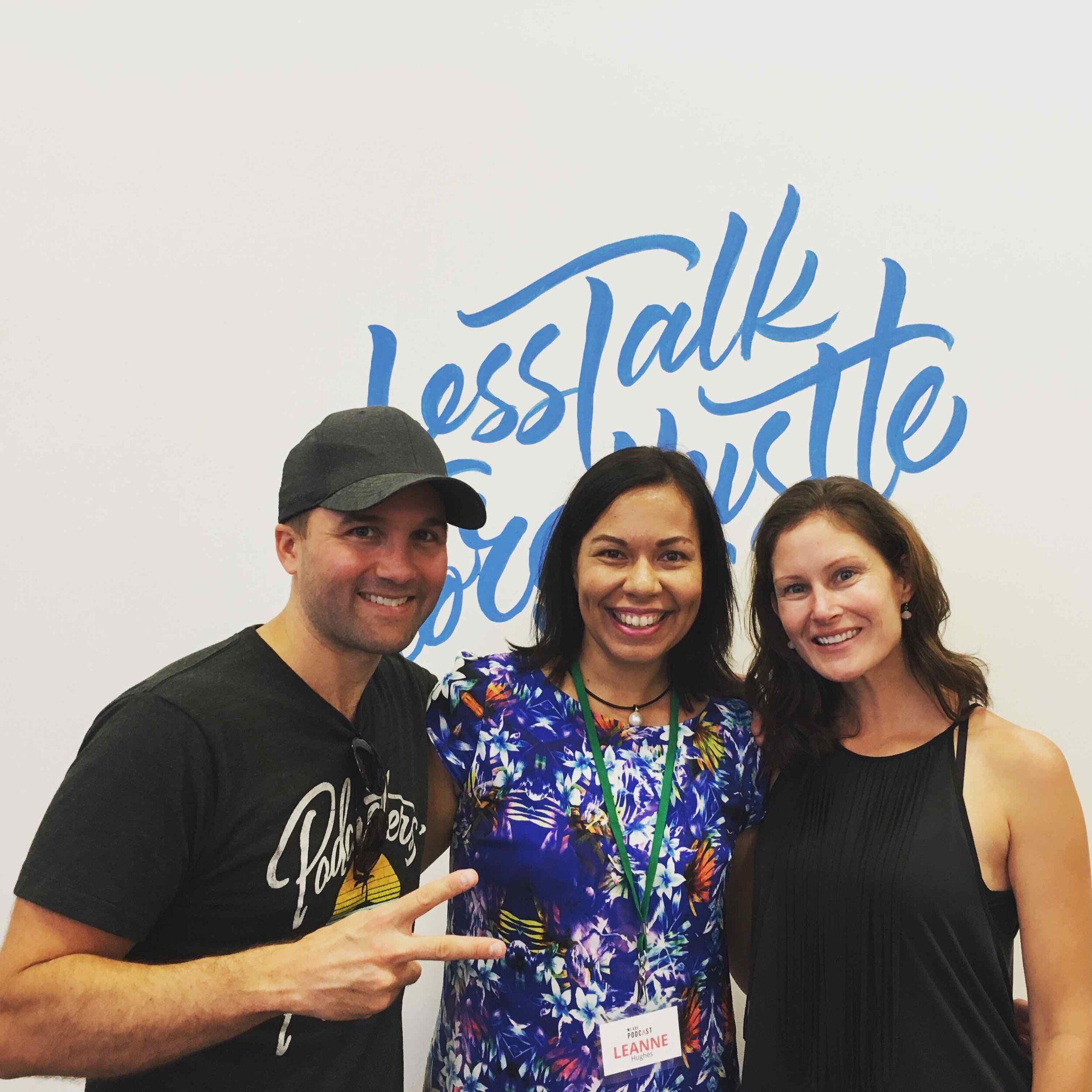 I’m used to attending conferences where the keynote speaker arrives five minutes before their spot, gives a pearler of a speech and then shoots off in a flurry.The biggest and best surprise about this conference is that the presenters hung around and they were accessible - you could walk up at any time for a chat. The chats weren’t one-sided either, they were genuinely interested and asked what you were up to and offered tips/advice. Thanks guys.
I’m used to attending conferences where the keynote speaker arrives five minutes before their spot, gives a pearler of a speech and then shoots off in a flurry.The biggest and best surprise about this conference is that the presenters hung around and they were accessible - you could walk up at any time for a chat. The chats weren’t one-sided either, they were genuinely interested and asked what you were up to and offered tips/advice. Thanks guys.
2. A Light and Bright Venue
I know there were some headaches with the audio, however, 5 stars to Fishburners as a conference venue. It’s centrally located, there are stacks of restaurants and pubs nearby, lots of natural light, cool break-out rooms and funky decor.I also liked that we weren’t thrown in like cattle and had to sit all facing the stage lecture-style. The conference room was setup cafe style, which allowed for easy conversation and note-taking.
3. Friendly, Community Vibe
Simon Sinek says ‘The leader sets the tone’ and I believe the architect behind ‘We Are Podcast’, Ronsley, reflected his brand and personality over the three days by creating a fantastic community vibe.The feeling in the room was casual and inspired; he hired a really great Master of Ceremonies, all of the staff members wore bold ‘Just Be’ black shirts and it was really easy to walk up to anyone and have a chat about their podcast, business, life.This was reinforced by the coolest roaming microphone I’ve ever seen - one that you can throw and catch to get questions from around the room. I had a look and you can buy it from GetCatchBox.
Here are the top two things I learnt from each speaker.
Day One: Workshop
A recap of the three workshops I attended on the first day.
Nicole Baldinu from the $100 MBA: Podcast Production Fundamentals
1. There are three key things you need to do when you decide to start a podcast. Nicole used the $100 MBA as her examples - I’ve included these below in italics.
- What’s the goal? Is it sales, engagement, to grow your community? (To teach real world business lessons)
- Determine the format of the podcast - interview format, quick tips, etc (Lesson-based, short format)
- Describe your show in one sentence (Daily, 10min lessons for the real world)
2. To create a point of difference, have a look at the other podcasts in the iTunes library for your category. Figure out how you can differentiate or add more value.
Stephanie Holland from Amplify: Amplify Your Product Launch
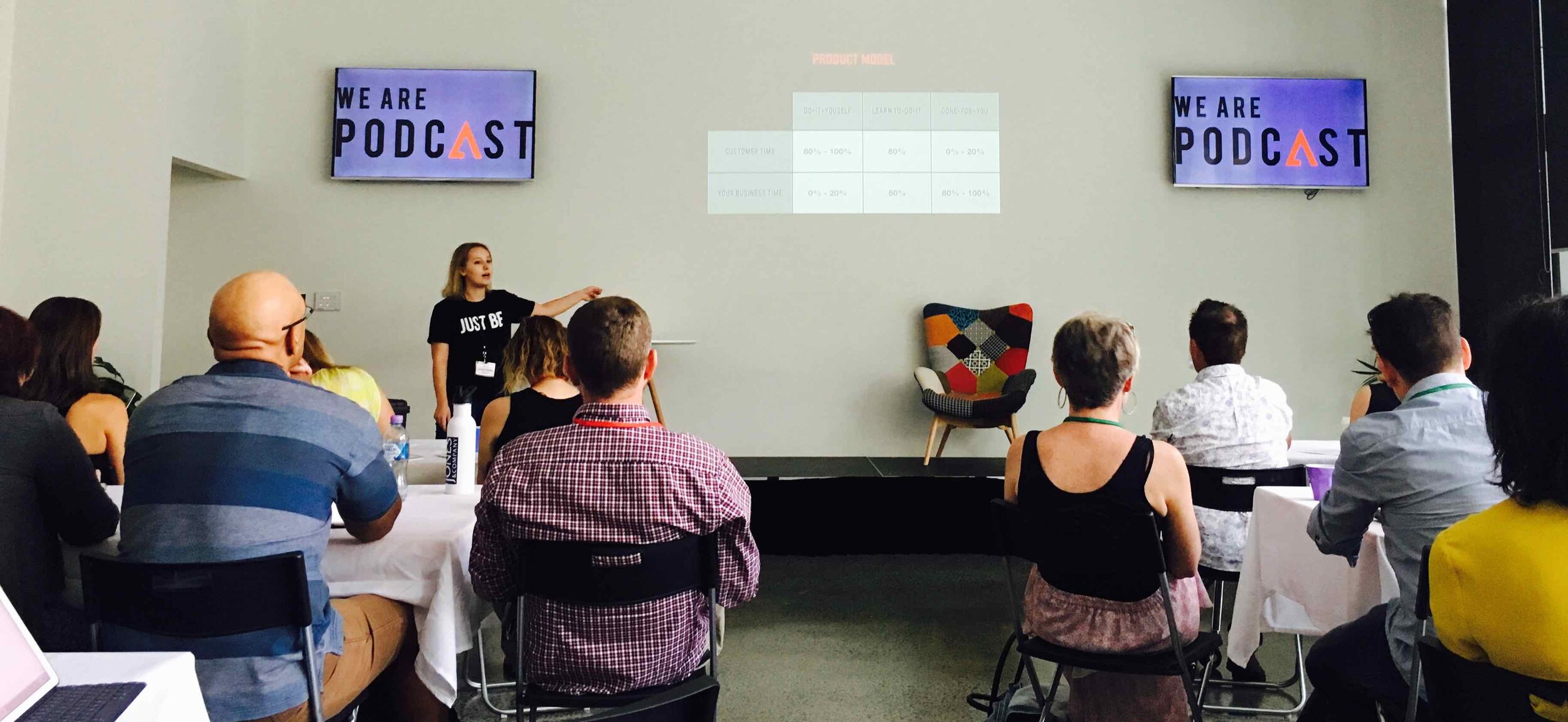 3. Think about your product. If you offer a 1-to-1 product offering, how can you scale it? If you offer a 1-to-many product, how can you engage 1-to-1 high profile/high paying clients?4. Zero Moment of Truth (ZMOT) - People read ten pieces of content before they buy from you (Author’s note: I can 100% relate to this - I bought the Apple Watch Series 3 on Thursday and read about 10 articles before making that purchasing decision. I would also add that the number of articles you read is proportional to the cost of said product)
3. Think about your product. If you offer a 1-to-1 product offering, how can you scale it? If you offer a 1-to-many product, how can you engage 1-to-1 high profile/high paying clients?4. Zero Moment of Truth (ZMOT) - People read ten pieces of content before they buy from you (Author’s note: I can 100% relate to this - I bought the Apple Watch Series 3 on Thursday and read about 10 articles before making that purchasing decision. I would also add that the number of articles you read is proportional to the cost of said product)
Jason M from the Portrait Store: How to take the ultimate headshot selfie
5. Do the turtle - lengthen your neck when you take a selfie and keep your chin down.6. Connect with your audience. Instead of holding the camera up high, keep it at eye level. Don’t look into the glass… find that little hole at the front of your mobile, the camera lens and look all the way into it.
Day Two: We Are Podcast Conference
Andrew Griffiths: Master of Ceremony
7. He set the tone brilliantly - nice and relaxed, had a lot of information to cover but made it fun8. Reflected really well on what was being taught on stage, summarised it neatly, added his own stories and experiences to emphasise key speaker points.
John Lee Dumas from Entrepreneurs on Fire: Podcasting with a Purpose
9. Before you funnel down, you must funnel up - niching down is important. It’s lets you dominate that niche and get the momentum going. For example, as a social media marketer your target audience could be male dentists, based in the Brisbane area. Once you dominate this niche, you can look at broadening your audience to female dentists, dentists based in Sydney, etc.10. Have one avatar - this is the avatar that is going to serve you the most. JLD’s avatar is a guy named Jimmy, mid 30,s who spends 25mins driving to work in the morning, spends 9 hours in a cubicle for a job he doesn’t like (35mins on the way home cause of traffic) and all Jimmy wants to do is go fishing. When you need to make a decision in your business, think ‘WWJD’ - What Would Jimmy Do?
Sean DeSouza from Psychotactics : Pre-sell: How we Sellout Products/Courses in Mere Hours
11. He started a business because he wanted control - he defined control as a state of freedom from worry about income. Over the last 17 years, he and his wife have had 3 months worth of vacations every year. He calls it - ‘downtime by design’. (Author’s note: Hear, hear!)12. He spoke about the importance of the pre-sell (‘People buy before they pay) and used the metaphor of an upcoming wedding to use as the format for your pre-sales (i.e. give away high level details and stagger these announcements over time).13. His secret weapon is sending physical product to his clients - it’s incredible what a personalised cartoon postcard and a box of chocolates can do!
Glen Carlson from Key Person of Influence: Assets of Influence
14. He highlighted proximity bias and that we tend to devalue the things that are close to us (I think this links into imposter syndrome). He likened this to our relationships, our thoughts and ideas.15. He said that any stress, frustration or bottle neck can be traced back to an asset deficiency. Give your teams/people more or better assets - don’t throw more money or time at your team’s problems, ask yourself the question: ‘What’s the missing asset?’.
Louisa Dahl from Interactive Minds: How to position yourself as an in-demand expert
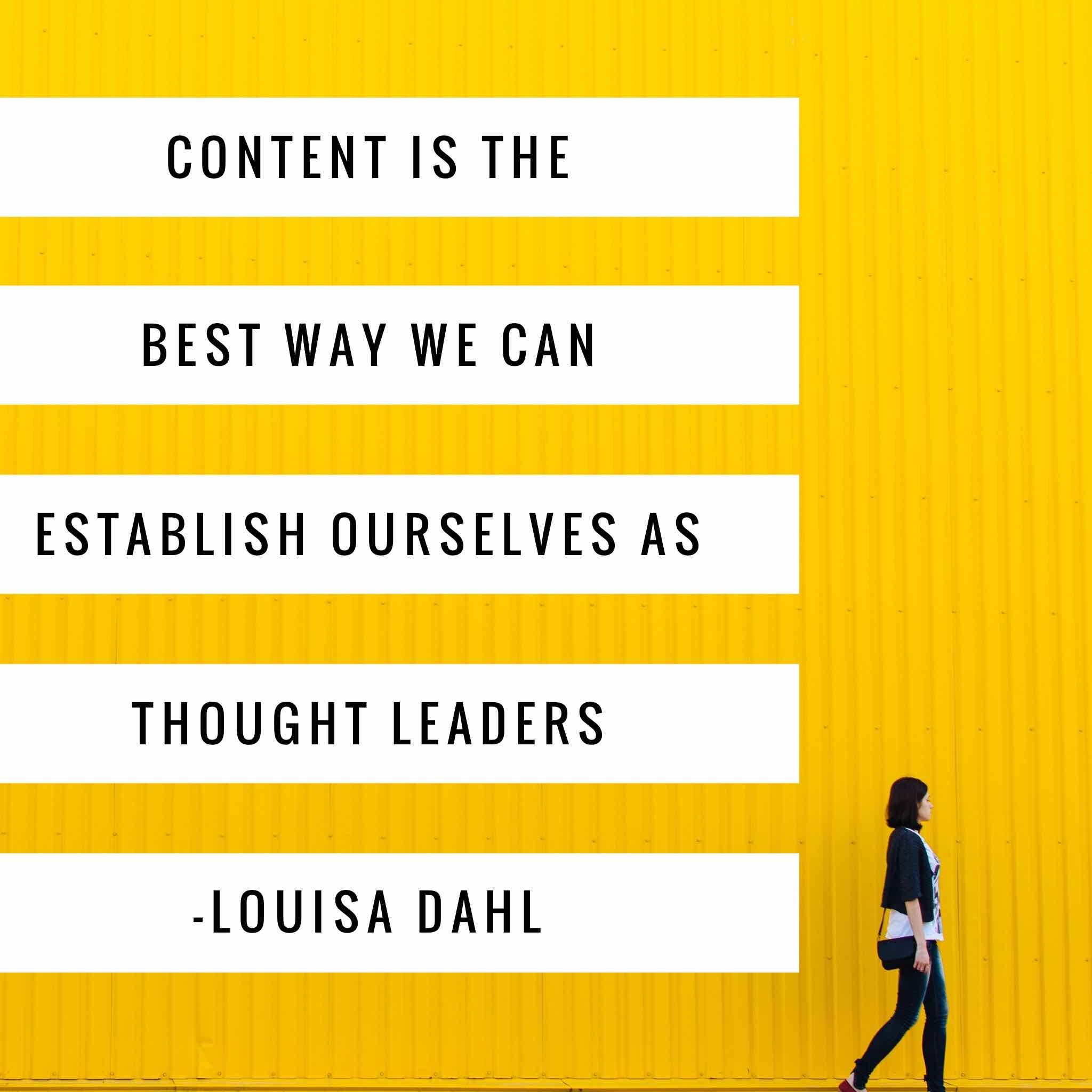 16. Think about your results and ask yourself how to make it real. For example, ‘How many widgets do I need to sell to make my own salary?’17. Content is the best way to establish ourselves as thought leaders.
16. Think about your results and ask yourself how to make it real. For example, ‘How many widgets do I need to sell to make my own salary?’17. Content is the best way to establish ourselves as thought leaders.
Clarissa Rayward from the Happy Family Lawyer: From Lawyer to Podcaster - Turning a traditional business on its head through podcasting
18. Build fast, fail fast - do the do. If you have to think of an idea, try ‘speed-thinking’ and giving yourself a tight deadline to make it happen. She provided a great example: If you need to go to work at 8.30am and you wake up at 8.20am… you still find a way of getting ready in time. Use the same thinking to get things done.19. Mindfully pay attention to the feedback that you’re receiving…there may be something in it.I had to leave the conference after this event at this stage to be the Master of Ceremonies at an awards night, so I missed the last few presentations from Danielle Lewis, Nathan Chan and Kate Erickson. But I had a great night’s sleep and was full of energy when I arrived for the final day.
Day Three: We Are Podcast Conference
Ronsley Vaz from Amplify: Product Ecosystems - Content assets and customer journeys
20. The question isn’t how to grow… it’s how to grow efficiently. This involves an overlap of Convincing, Converting and Automating your customers/systems and processes.21. Treat your customers like an intimate relationship - you don’t ask someone to marry you when they first meet you, so stop aggressively sell them stuff! Work your way through four stages:
- Attention (Solve a headache)
- Engagement (Remove obstacles)
- Sales (Address an aspiration)
- Client (Pursue a desire)
Amber Hawken - The Skill of Selling from your Soul
After busting out the macarena, we learnt to:22. Remember that when you are doing anything (particularly podcasting) - it’s not about you. It’s always about your audience.23. Our heads feel fear and rejection. When you’re working on your business, try to get out of your head and just be/do/create.
Omar Zenhom from Webinar Ninja
24. We need to incorporate Webinars into our marketing efforts for three reasons.To:
- Collect emails
- Create trust as it’s a two-way conversation
- Grab attention - You can do similar things on Facebook Live, but Facebook is full of distractions; where as webinars are a controlled environment.
25. You create your webinars for three different types of audiences:
- Never heard of podcasting
- Never heard of your podcast
- Have listened to a podcast but haven’t subscribed.
Yann Ilunga from 360 Entrepreneur: Podcast to Virtual Summit
26. He outlined how to use your summit to build your audience and to approach promotion of your virtual summit like a music festival.27. He brought up a great point about making it easier for your summit guests to promote their interview by sending them Canva images and spiel.
Emma and Carla from The Merry Maker Sisters: Five things we’ve done to create an awesome, loyal community
28. Treat your community at the same level as you. Value your brand champions.29. They’re successful as they have fun. They evaluate an idea and if it doesn’t make them excited, the idea is benched.
James Tuckerman from Not So Freaky University: The 12 Principles of Persuasion and Influence
I won’t outline all of the twelve steps but my favourite ones were:30. Clarity booster - you can describe this in three different ways:
- Outcomes
- Things (most people say this
- Feelings
For example, you say you’re in the business of ____ (things). But, all your customers really want is a ‘fist-pumping moment’ (a feeling). It’s important to identify all three.31. De-risk it - Highlight the potential Return on Investment - but talk more in terms of the potential cost of inaction. This is what drives 80% of action. For example, would you be more motivated to run towards a cuddly bear; or run away from a grizzly bear?
Michael O’Neil from the Solopreneur Hour: The Art of the Interview
32. When you introduce your guests, the last two words should be their name (example, ‘…She’s based in Brisbane and I’d like to welcome award-winning author, Jane Smith).33. You want your guests to talk in stories. His all-time favourite question to ask guests is ‘What does your child-hood smell like?’ as this evokes feelings and stories that you can often relate to through the interview.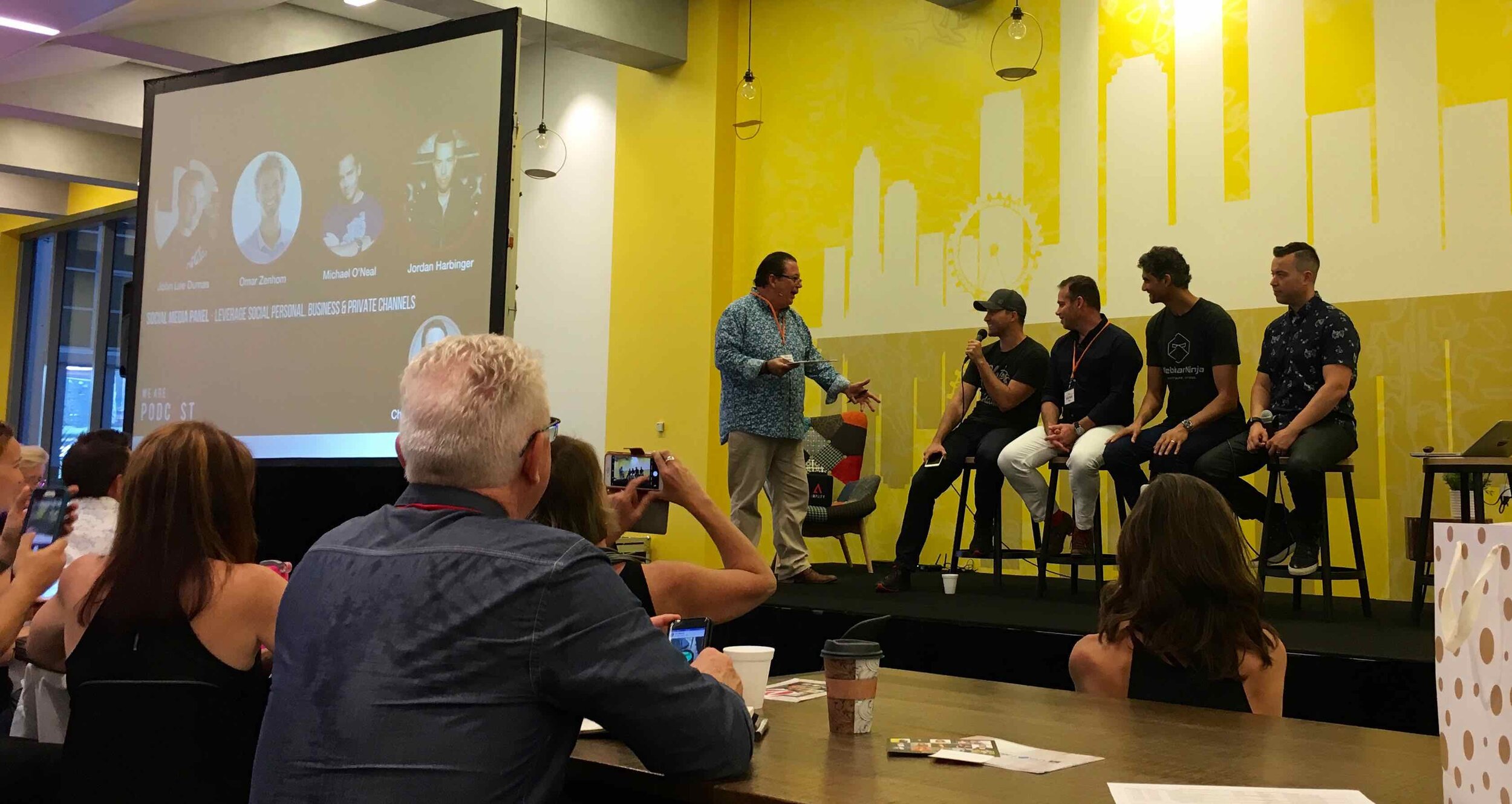
Jordan Harbinger from the Art of Charm: How I learnt to network from getting kidnapped
34. Put 1-2% of your salary into a ‘holding fund’ so if an amazing conference comes up which involves travel/cost - you can attend through proper planning.35. The best value is not in your bank account - the best value is your network. List the top 10 people you would contact if you lost your job tomorrow. How are you keeping in touch with them and offering them value? Always give value.
On another note...
Funny story. MC Andrew announced that there would be a lucky draw prize on the third day. All you needed to do was write down your name, your podcast title, what it was about and pop this in the draw. I don't have a podcast but I entered anyway. My philosophy was 'If I get selected, then it's a sign that I need to start it'. At the end of the day, my idea was plucked out of the draw! Crazy. Guess I better get to work so I can report back to Ronsley and the team at We Are Podcast 2018...Do you agree with these podcasting and business tips or have any more to add? Comment below![contact-form][contact-field label="Name" type="name" required="true" /][contact-field label="Email" type="email" required="true" /][contact-field label="Website" type="url" /][contact-field label="Message" type="textarea" /][/contact-form]
We’re Still Standing! Drawing leadership insights from Elton John’s concert in Cairns
I travelled to Cairns this long weekend to see Elton John play at Cazaly’s Stadium. I was fortunate and excited to have a front row seat – Seat 1A! When the music started, a few of us began to stand and dance in our seats but were quickly told by security guards to sit down. As the concert progressed, more fans were migrating closer to the stage and dancing along to the infectious tunes.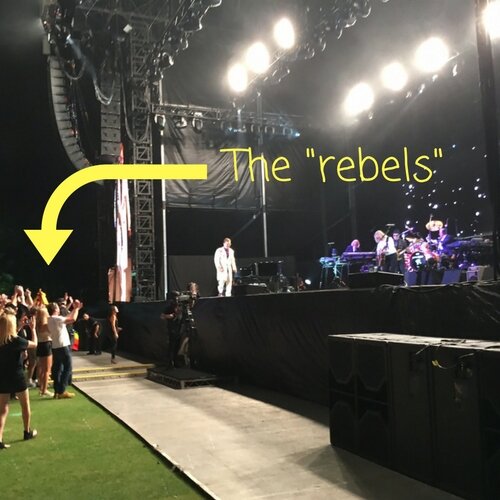 It was becoming harder and harder for security to stop us. At one point, there were about 30 people at the front dancing along to Elton’s iconic songs – how could you not? Shortly after witnessing the security guards’ feeble attempts to control the crowd, Elton barked out “For goodness’ sake, let the people stand! This is a rock concert – not a protest!”
It was becoming harder and harder for security to stop us. At one point, there were about 30 people at the front dancing along to Elton’s iconic songs – how could you not? Shortly after witnessing the security guards’ feeble attempts to control the crowd, Elton barked out “For goodness’ sake, let the people stand! This is a rock concert – not a protest!”
Well, when Elton talks, people listen.
Immediately that message from the top opened the floodgates. Hundreds of people swarmed to the stage and the atmosphere in the stadium amplified, with the band feeding off of the delight of the crowd.
How does this relate to leadership in business?
In Simon Sinek’s TED Talk, 'Why good leaders make you feel safe’ (video below), he discusses leaders setting the tone and the environment (or ‘level of safety’) that employees feel within an organisation. When employees on the ground have high trust/safe environments, they feel empowered and supported to make their own decisions.
The security guards were following their direct leaders’ instructions to ensure the safety of everyone at the stadium. They were doing their absolute best to prevent fans from swarming upfront. The ‘threat’ that we felt in the crowd was that if we were to dance/stand up too many times, we may be ordered to leave the event.However, it took only one sentence from the ‘organisation’s’ principal leader, Elton, to set a new standard. By telling us we were allowed to stand, he instantly changed the environment to one where we felt safe to dance, sway and twirl without the threat of eviction hovering over us.I spoke to the security guard following the event and asked how he felt in that moment. He laughed and shook his head, saying “It was impossible to reinforce our directions after Elton’s call”.It made me think about middle managers in organisations who believe they are doing the right thing (by reinforcing a directive they have been given) and the confusion and frustration they may feel when a more senior leader talks directly to their team and changes the environment they are responsible for.It’s almost as if the managers are stripped of their credibility to continue the job they were tasked with, as they have essentially been overruled and undermined. It may cause them to throw their figurative arms in the air, thinking ‘What’s the point?’ The other interesting question this scenario raises is, why are middle managers reinforcing behaviours that are not supported by the organisation leaders? Where/when/why is the message lost in translation?
What else did I learn?
Another thing I loved hearing is that the band’s 66 year old lead guitarist, Davey Johnson, has played over 2,800 gigs with Sir Elton. He and his band-mates are still having the time of their lives on stage, playing music together like it was their first time. You feel that energy and passion coursing through your own veins. It’s truly a joy to go to these gigs and watch people publicly display the love they have for their job – it’s their life’s purpose.And if you ever get the chance to see Elton play, do it! It was the best gig ever. Oh, and thanks for the guitar pick, Davey!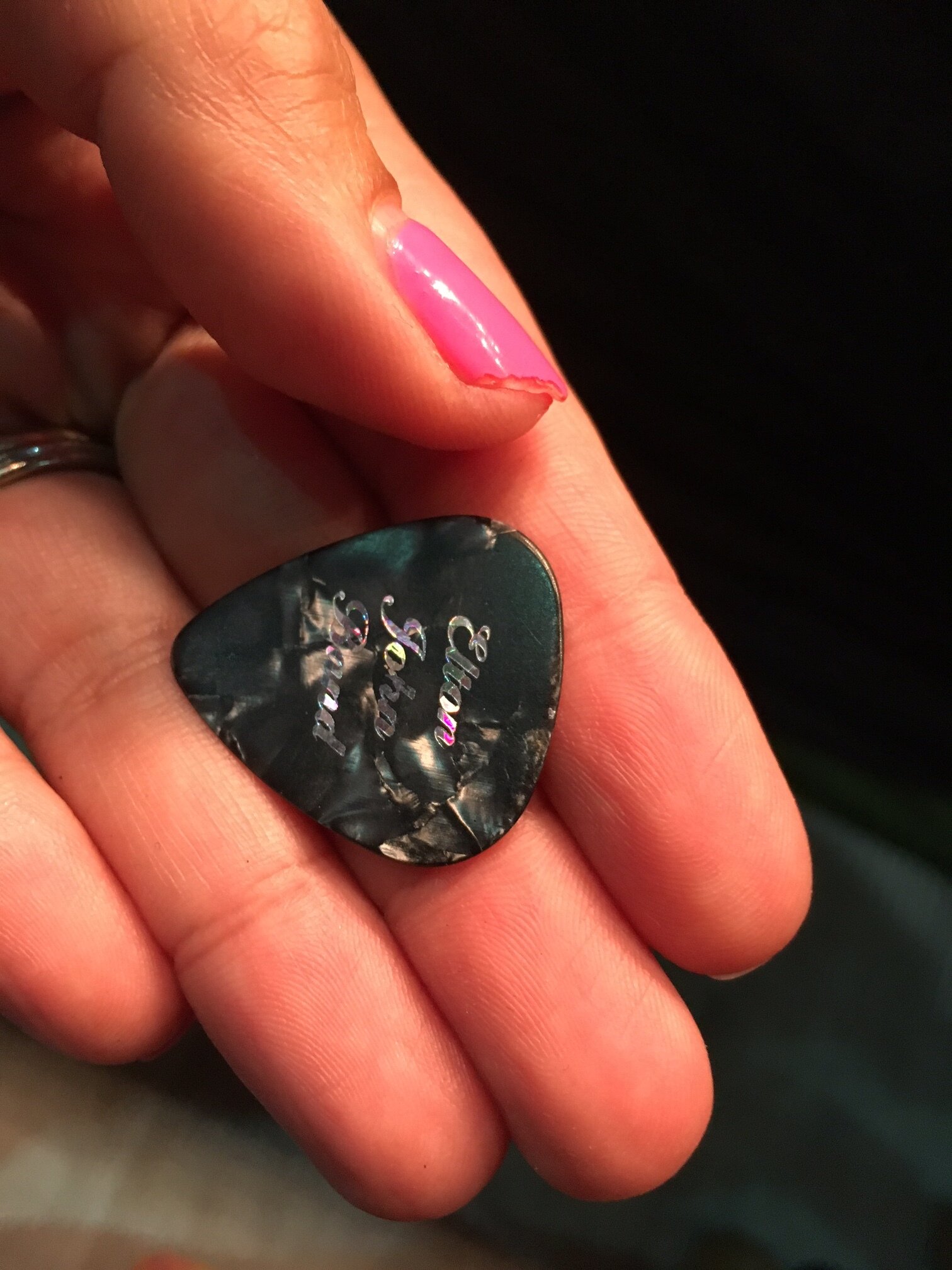
Disrupt HR: The Creative Process in 7 Simple Steps
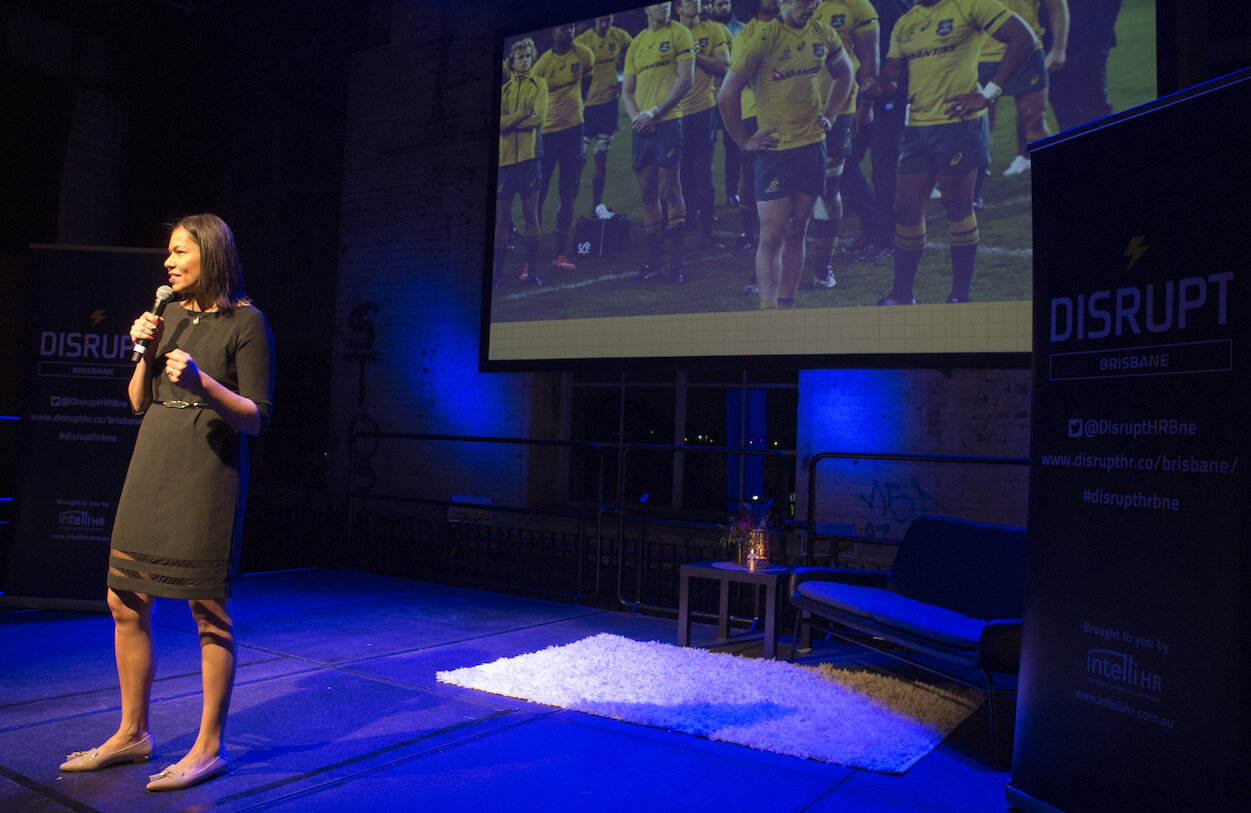 Last month I was up in lights at the Disrupt HR event in Brisbane. It’s the first time the event has been brought to sunny Queensland and the HR Community in the river-city came out in their droves, to hear from nine diverse speakers about the Future of Work.The format for the presentations is fast and furious – 20 slides with only 15 seconds spent on each slide. That’s 5 minutes to ignite some interest in the audience, lead them down the road with a story or personal anecdote, throw some stats around and inspire them to take action. Yes, it’s a tough gig.Here’s the video of my presentation ‘How one switch can improve your nine-to-five'’. I spoke about something really simple - office furniture, in particular, the sit-stand desk and its impact on productivity and quality of work life.How One Switch Can Improve Your Nine-to-Five | Leanne Hughes | DisruptHR Talks.When you write for Disrupt HR, you really need to consider your topic. I learnt a lot while preparing for the stage and thought I’d share my tips.But before we start, I want you to put yourself in the ring and:
Last month I was up in lights at the Disrupt HR event in Brisbane. It’s the first time the event has been brought to sunny Queensland and the HR Community in the river-city came out in their droves, to hear from nine diverse speakers about the Future of Work.The format for the presentations is fast and furious – 20 slides with only 15 seconds spent on each slide. That’s 5 minutes to ignite some interest in the audience, lead them down the road with a story or personal anecdote, throw some stats around and inspire them to take action. Yes, it’s a tough gig.Here’s the video of my presentation ‘How one switch can improve your nine-to-five'’. I spoke about something really simple - office furniture, in particular, the sit-stand desk and its impact on productivity and quality of work life.How One Switch Can Improve Your Nine-to-Five | Leanne Hughes | DisruptHR Talks.When you write for Disrupt HR, you really need to consider your topic. I learnt a lot while preparing for the stage and thought I’d share my tips.But before we start, I want you to put yourself in the ring and:
Back your experience and your public speaking ability - then DO IT. Submit your application.
When I read on LinkedIn that Intelli HR were bringing the event to Brisbane, I thought ‘Geez that event looks interesting! I’ll DEFINITELY grab a ticket and tell my colleagues all about it too’.A few minutes later, my thoughts changed to, ‘Hey…I think I could actually speak at this thing’. I resonated with the tagline of the event: ‘DISRUPT is an information exchange designed to energize, inform and empower people in the HR field.’I love all things disruptive, so I expressed my interest with the event organisers, told them a bit about myself, outlined a couple of topic ideas and then forgot all about it.A few weeks later I received the call up. I was locked in to the program. And I was terrified.
Why did I sign up and why do I recommend you do the same?
I recently listened to this podcast from Pat Flynn – ‘Why you belong on Stage – Pat’s “braindump” of public speaking and presentation tips’. He explains how public speaking changed his life (how it helped to build his personal brand/credibility, led him to new opportunities, and opened his door to meeting other influencers), and other compelling reasons that will have you on the stage in no time. I recommend you plug in those headphones, go for a walk and listen to Pat’s wisdom. But if you don’t have that much time than this image pretty much sums it up: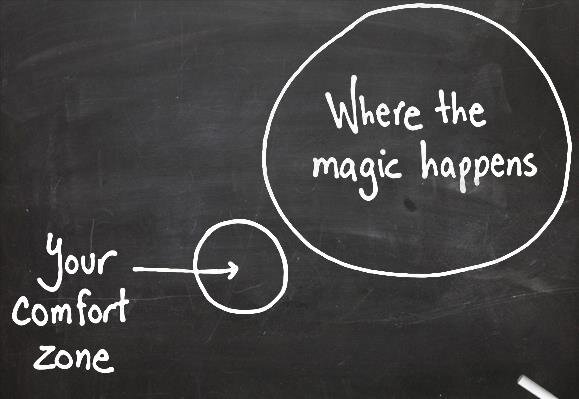 You may be thinking 'I don’t know what to talk about', 'I don’t have credibility in any particular HR niche', 'I can’t memorise my speech' or 'I’m not creative'.And guess what? That’s completely normal. Most (if not all) speakers up on stage have had these thoughts at some stage in our career. It's whether you choose to ignore them and forge ahead, which makes all of the difference.Through this process working on my speech, I went through all stages of the change cycle. Denial, particularly, which manifested in the form of procrastination. Six weeks out I needed to submit my topic idea and a brief descriptor.Here’s a little wrap-up of the 7 step process I went through to deliver my Disrupt HR speech, from topic generation through to performance.
You may be thinking 'I don’t know what to talk about', 'I don’t have credibility in any particular HR niche', 'I can’t memorise my speech' or 'I’m not creative'.And guess what? That’s completely normal. Most (if not all) speakers up on stage have had these thoughts at some stage in our career. It's whether you choose to ignore them and forge ahead, which makes all of the difference.Through this process working on my speech, I went through all stages of the change cycle. Denial, particularly, which manifested in the form of procrastination. Six weeks out I needed to submit my topic idea and a brief descriptor.Here’s a little wrap-up of the 7 step process I went through to deliver my Disrupt HR speech, from topic generation through to performance.
Step 1. Topic choice
By far, for me this was the trickiest of all the stages. I read a lot of blog posts and article on which topic to choose from and spent a while fleshing out ideas using mind maps.My criteria was that I wanted a topic which was fairly pragmatic, meaning that it was useful for the audience and they could take practical action the minute the speech was over.However, after listening to Michael Port’s podcast, ‘Steal the Show’, I realised that I was going about this all the wrong way...
The real Step 1 is: Profile the audience
The event isn’t about you, it’s about serving your audience and determining what’s in it for them.Think about the type of people that will attend an event like this. The brief attracts a local HR professional type audience. Think of a HR professional, one person in particular and profile their demographics - gender, age, education.Map out their career needs, fears, wants and frustrations.Think about:
- Why they’re attending a HR event after a long day at the office, when they could be spending time with their family.
- Why they’re attending an event that talks about disruption.
The key here is to not think about this criteria too broadly, you really want to target one person. As you work in the HR space, think of a colleague or boss that you could profile.Through this process, I realised that the majority of HR Professionals still work in an office environment and there are common concerns associated with that, such as our lack of movement and collaboration when you sit in the same spot, every day.This linked into something I’m passionate about - which is physical activity and how standing up while working can make you feel great, as well as lift your levels of innovation, collaboration and efficiency.You really don’t want to spend too long in the topic choice stage. Once you’ve made the decision, commit to it and cut off all other options. You still have a lot more work to do.
Step 2: Researching the topic
At this stage you want to use a range of sources, such as:
- Your own personal anecdotes and experiences (start thinking of interesting stories related to the topic)
- Data/research/stats to support your idea - Spend a couple hours on Google- I’d recommend both academic articles and also researching interesting blog perspectives.
- Chatting to other people on their thoughts to validate your topic
- Podcasts related to the area (makes it easier when you’re commuting/walking/don't have time to sit down and read)
I spent a few hours over two days, gathering all my stats, quotes and information together. With all of the information collated, I realised there were three broad themes to address;How sit-stand desks improve:
- Your health
- Your productivity
- Your levels of collaboration in an open-plan office.
Step 3: Drafting the speech
I spent most of my time in this phrase, writing and re-writing content, deleting, adding, tweaking and re-inveting… this is unavoidable.The good news is, that the PowerPoint slide auto-advancing speech format isn’t new. I drew inspiration from blog articles based on the Pecha Kucha format (20 slides x 20 seconds), particularly this one: Your Ultimate guide to giving PechaKucha presentations’.I also drew inspiration from the book The Presentation Secrets of Steve Jobs: How to Be Insanely Great in Front of Any Audience (Business Skills and Development) by Carmine Gallo. In the book, Gallo outlines how Steve Jobs used to sequence his big product talks in ‘rules of three’. He also used simple, visually powerful slides and he used stories to create ‘pain points’. After setting the audience up, he then offered the audience a solution to these problems (eg. the iPhone).As your speech time is limited, you need to use your visual slides to support/amplify your key messages and arguments. To plan this, I drafted my speech in a table with the following column headings:
- Slide number (1-20)
- Topic (eg. How sit-stand desks support Health)
- Content (data, stories to support stories)
- Slide image ideas (visual elements that make the content come to life)
I calculated my speech pace at 900 words over 5 mins (pretty quick) and I had written 1800 words. Cutting back was tough - it’s a balance of giving the audience enough to understand your message; but nothing too prescriptive that you’re spoon-feeding them.I dedicated 40% of my speech to setting the pain point (how our lack of movement is slowly killing us). The remainder of the speech was offering a solution. I also spent two slides opening up the presentation talking about something completely unrelated to the topic, the Wallabies recent form in the rugby league. This was to draw the audience in and to start them thinking 'How on earth does this relate to us?'How to defeat that writer's block? My tip for writing a speech is to pretend you’re writing for the rubbish bin. You just need to get those thoughts down, no matter how ridiculous and lame they sound at the time. From there, you can edit – add, tweak, adjust as needed, but building momentum is important.While drafting the speech I was also open to incorporating other concepts (especially after listening to Michael Port’s interview with Neen James on creating contextual models). I listened to another podcast where Michael Port interviewed author, Jonathan Fields. Jonathan was introducing his Good Life Project. He spoke about all of us having three buckets in our lives - our Contribution, Connection and Vitality buckets. I loved the law of the buckets and realised it was the perfect contextual model to align with my topic.I raced back home that night and read more about from Fields on How to Live a Good Life: Soulful Stories, Surprising Science, and Practical Wisdom
Step 4: Create powerful slides
I think slides are an element that speakers don’t prepare enough for/are understated.Remember, each slide flashes only for 15 seconds, so the slide must be strong, less words (or words with impact), bold, large visuals.Limit collages. Limit low-resolution files. Limit the clip-art.Each slide must support your argument and draw your audience in.Another simple tip - keep a simple visual theme weaved throughout the presentation. I chose a theme through Canva to design my slides.
Step 5: Do your first paper reading
Once you’ve drafted the speech, Michael Port suggests you do a ‘paper reading’. This is where you print your draft speech notes out, sit at your dining table and read your script aloud in a normal voice. This is a really useful exercise where you can determine which words/phrases feel comfortable off the tongue and sound authentic to you. You can extend this further and start ‘blocking’ your speech. This means, highlighting words where you’ll pause, increase volume and change tone. You can also block your movement - such as walking at a specific time, where you'll move your arms to emphasise a point, etc.Once you’ve done a couple of these, lock that speech down and move onto…
Step 6: Rehearse, rehearse and rehearse…Then, rehearse again
If you present at one of these gigs, the biggest challenge is that you can't take speech notes on stage.I don’t know any quick memorisation hacks. For me, it was all about practising when I had the chance. One practical tip I recommend is to record your speech into your Voice Memos iPhone app. I did this and would play it back when I was driving, out for a run or walking the dogs - it was an effective way to rehearse along.When I was getting the ‘hang’ of it, I’d start rehearsing from a quarter/half the way through the speech.I also recommend rehearsing in front of a trusted advisor. I’m lucky I work with a fantastic, HR professional (thanks Jordana) who gives excellent and honest feedback. The external validity and advice gives you confidence that a) You’re on the right path or b) Yes you need to tweak some things but you'll be good on delivery day.
Step 7: Showtime
Try to get a good night’s sleep the night before your performance!I didn’t rehearse too hard on the day, as I knew the time I had invested leading up to this moment had served me well. All I was focused on before the speech was staying relaxed, warming up my voice, and reminding myself to enjoy the moment.One of my favourite videos that I show anyone I help prepare speeches with, is this TED Talk from Julian Treasure – I usually start it from the six minute mark.Pat Flynn said that it's important to arrive early and mingle with your audience. He learnt this from Dale Carnegies’ book ‘Stand and deliver’. The purpose of this is two-fold:
- You connect with you a couple of people so it doesn't feel like you're presenting in front of a bunch of strangers (no longer as strangers)
- The audience members think it’s pretty cool that they’re meeting someone who is about to walk on the stage.
Conclusion
Phew! A lot of tips and detail there. Finally, just enjoy the rush of being up in lights. It’s an amazing experience and a mega adrenaline rush.Special thanks again to the team at IntelliHR for a superb evening and I will be plugging the next version when it hits Brisbane next time.














